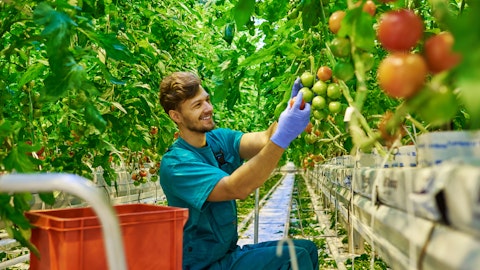And as we said in the opening remarks, offset by really continued strength in baby food and purees, and especially in toddler snacks, both in the Ella’s business in the UK and in Earth’s Best in the US. So as the formula situation rights itself in the back half of the year, that gives us confidence because we have secured that supply, it gives us confidence as we go forward in that category. Personal care, we identified it, on Investor Day, we talked about this as a stabilized category. If you look at the brands underneath that the sun care business in Alba is a timing issue, and that really was a driver to the personal care piece. But we had strength in the Avalon brand, strength and Live Clean, which is a leading brand in Canada. So there’s pieces and pockets of personal care that give us confidence as we go forward.
So I guess long way of saying I think there are some, those were discrete items. When we look at outside of baby formula, the balance of the categories, we feel good as we go forward. And I believe our outlook for North America, well total company has a pivot into growth as we go into quarter two. But I’ll let Lee provide a bit more color relative to North America.
Lee Boyce: Yeah, I mean, I think you covered kind of all of the big points there. I mean, obviously in Q1, it was, formula was kind of the largest drag on us. Going into Q2, we do see a continued drag on formula, probably around $10 million on the revenue side but then pivoting back as we go through the balance of the year. So I think again, we’d outlined what, I wasn’t here but we had outlined previously kind of the three drivers with formula being the largest one.
Operator: The next question we have is from John Baumgartner of Mizuho Securities. Please go ahead.
John Baumgartner: Good morning, thanks for the question.
Wendy Davidson : Good morning.
John Baumgartner: First off, I wanted to ask about International. Had a nice recovery there in Q1, the plant and beverages categories bouncing back in Europe and your comments, Wendy, they sound pretty positive to the larger portfolio in the region. So if I weigh that against the segment guidance for this year, I think it’s up low single digits for organic revenue. How do we think about the potential upside to that outlook and what’s holding you back from being more bullish for International sales this year?
Wendy Davidson: Yeah, I appreciate the question, though, if you think about even what we outlined on Investor Day and what we guided in the last quarter, there were some very clear areas where we expected to see recovery in International. We expected to see recovery as non-dairy beverage came back, and we got to greater capacity utilization in our non-dairy beverage plants. We expected to see some recovery as we see consolidation in the meat-free category, and we expected continued strength in our jams and jellies business and our soups business. So all of those things we have seen play out. Those are, however, offset by the challenges we see in the marketplace. The European market has been more, the consumer, more acutely impacted by inflation and the economy than what we’ve seen here in the US.
It’s also a market that has more private label penetration than what we see in the US and really in North America. The benefit for us is we play in both private label and brand, and that certainly was a benefit for us in the first quarter. We see that playing out as we go into the back half of the year, but I would tell you that we’ve tempered our expectations based on consumer response to category, the challenges around some of the geopolitical conflicts that we’re seeing, especially in Ukraine and now in the Middle East, and so I think we’ve been appropriately prudent as we look at what the outlook is in the back half of the year.
John Baumgartner: Okay. And then just a follow-up, when we think about a new distribution, the distribution growth you’re getting in away-from-home channels, how do we think about the phasing there? Are there certain selling periods where the benefits can be larger than others, where if you’re loading for K-12 or university business, are there certain windows akin to shelf resets that retailers should be considering? I’m just trying to better understand any lumpiness we can expect seasonally in away-from-home based on your targeted mix of new outlets.
Wendy Davidson: Yeah, away-from-home operates very differently, as you know, than a traditional retail environment. So there’s very little of sort of set reset time period, and it’s much more contractual depending on the segments that we’re leaning into. We will begin, and we have begun, to see incremental placements that start to generate some sales momentum. It won’t be as lumpy as what you would expect to see in some of maybe the other retail environments, where there’s a big load-in period, or even what some people would see in, say, restaurant business, where you might land a new item, you’ve got a significant increase in a particular time period, and then it comes off the menu, or it’s no longer on promotion. The segments we’re going after are largely where you would expect to see regular repeat business for the product being available, so think micro-markets in the front end of hotels, think travel as you’re going through airports, things like that in grab-and-go locations.
Think about on-the-go convenience, and think about college and university which functions very much like a small city that have convenience stores and small retail outlets on campus. Those tend to be fairly run rate business. You land distribution, and it slowly builds over time without the big inventory load-ins that you might see on it in a retail environment. So hopefully that provides a bit more clarification.
John Baumgartner: Yeah, thanks, Wendy.
Wendy Davidson: You bet.
Operator: The next question we have is from Michael Lavery of Piper Sandler. Please go ahead.
Michael Lavery: Thank you. Good morning.
Wendy Davidson: Hey, good morning.



